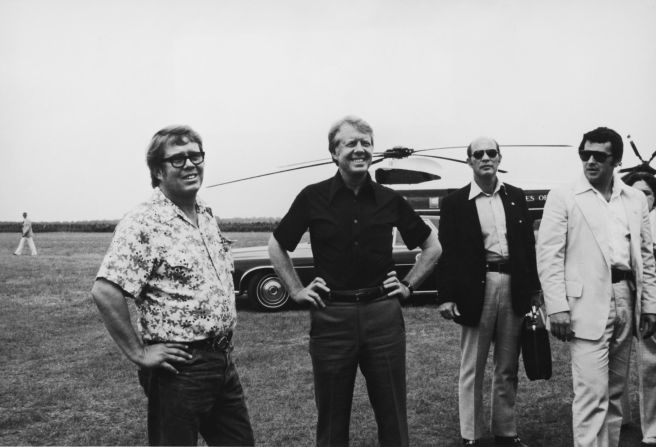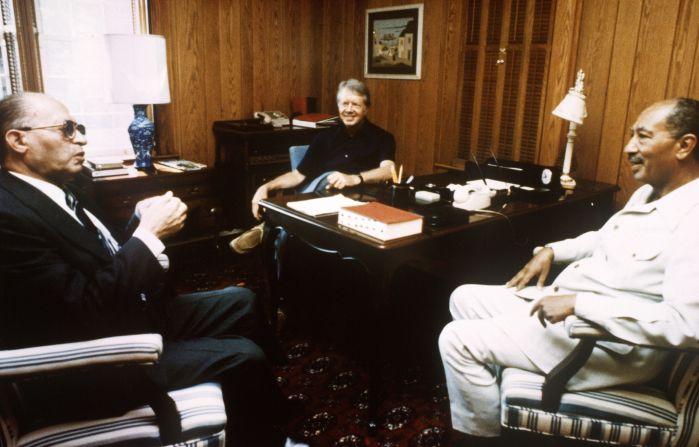Editor’s Note: Julian Zelizer is a professor of history and public affairs at Princeton University and a New America fellow. He is the author of “Jimmy Carter” and “The Fierce Urgency of Now: Lyndon Johnson, Congress, and the Battle for the Great Society.” The opinions expressed in this commentary are solely those of the author. “The Seventies” airs at 9 p.m. ET/PT Thursdays on CNN.
Story highlights
Julian Zelizer: Accord between Israel, Egypt an enduring achievement for Jimmy Carter
Zelizer: Officials grappling with other countries in region should study how he pulled it off
I was 9 and sitting in my grade school classroom when our teachers stopped the class so that we could all watch a special event.
They rolled in a wobbly plastic cart with a color television on top, and for the next hour, we watched as President Jimmy Carter stood side by side with Israeli Prime Minister Menachem Begin and Egyptian President Anwar Sadat to sign a historic peace accord, the first real diplomatic breakthrough in the Middle East.

It was March 26, 1979. I can recall that tears were flowing from my teacher’s eyes. All the students clapped. It was one of my first vivid political memories.
What is remarkable is that more than 30 years later that Camp David peace accord has held. The popular memory of Carter may be of his failures to do almost anything successfully, but this diplomatic achievement remains a remarkable moment of presidential leadership in international relations – a model for future presidents as they try to pursue peace in the turbulent region.
How did it come about?
Sadat had made a bold move to shake the war-torn status quo of the region. In November 1977, the Egyptian President made a historic visit to the Israeli legislative branch, the Knesset. The reasons for his surprise visit were complicated, ranging from a genuine desire to achieve peace, to his own struggles with the Muslim Brotherhood, to the state of the Egyptian economy, languishing as support from the Soviet Union diminished.
Nine things you may not know about Jimmy Carter
Sadat called for peace. “If you want to live with us in this part of the world,” he told the Knesset in Arabic, “in sincerity I tell you that we welcome you among us with all security and safety.” Begin, the hard-line Likud Party leader who had only recently become Prime Minister of Israel, was impressed and decided he was open to negotiations. “We, the Jews, know how to appreciate such courage,” Begin said.
Carter seized the opportunity. The intervening months were not easy. In March 1978, the Palestine Liberation Organization conducted a horrible attack – entering the country through the beaches near Tel Aviv, and traveling on Zodiac boats – that resulted in the death of 38 Israelis, including 13 children. “Gone forever are the days when Jewish blood could be shed with impunity,” Begin declared angrily to the Knesset. Israel responded with a bombing campaign of PLO outposts in Lebanon that killed thousands.
Trying to make progress, Carter invited Begin and Sadat to meet at Camp David from September 5 to September 17; Rosalynn Carter had suggested that this would be an “ideal place,” Carter writes in his new memoir.
As Lawrence Wright brilliantly recounts in his recent book, each leader brought considerable psychological baggage to the table. Some would argue that Carter’s ability to advance negotiations represented one of his finest moments. He began the meetings by telling the participants that if the discussions failed, “I would make public my final proposal and let each of them explain why he accepted or rejected it.”
The meetings took place in the kind of secret environment that Carter had once blasted previous presidents for embracing. The staff severely limited media access and worked hard to prevent any leaks. The negotiations were intense. Carter, who clearly liked Sadat more than Begin at a personal level, acted as a go-between. After three days with no progress, the President separated the two men and met with each independently, trying to find common ground.
Carter insisted on a comprehensive peace plan for the region that included disputed territory between the Egyptians and Israelis as well as a deal on the territory in the West Bank. The President thought that peace with the Palestinians was essential for a broader peace in the region. But as the negotiations progressed, he realized that reaching a deal on the Sinai Peninsula was in fact the best path to a deal, and agreed to drop the Palestinian issues.
Sadat was upset because he too felt this essential, and worried about the political consequences he would face for reaching a deal without this as part of the package.
As the negotiations reached the end, the situation seemed bleak, and Carter came down hard on both men. He said to Sadat that if he left without a deal it would create irreparable harm to U.S.-Egyptian relations and their own personal friendship.
In a crucial exchange, Carter went in to meet with Begin, who was angry with the President and the way the meetings had unfolded. Carter, who was pessimistic that they could reach a deal, decided to bring eight signed photographs that Begin had requested for his grandchildren. When Carter presented the photographs, Begin felt deep emotion. He started to call out the name of each grandchild and in the end urged the President to try one last time.
His lobbying worked. The 13-day negotiations produced a “Framework for Peace in the Middle East,” which outlined goals that included Israeli withdrawal from the Sinai and Egyptian recognition of Israel. The agreement left out the issue of the West Bank.
Although polls showed a surge in Carter’s ratings, his adviser Hamilton Jordan almost blew the political gains when he boasted that the United States had “broke the back of the Israeli lobby.” The negotiations then entered a slower period. The Israeli Knesset approved the peace plan, though Begin also agreed to the construction of more Israeli settlements in the West Bank, which inflamed the situation.
Although Carter is often remembered as ineffectual at politics, in this case the administration conducted a massive campaign to win over the support of the Jewish community. He held regular meetings with its religious and organizational leaders, and even appeared in a number of synagogues, famously wearing a kippah, to assure the Jewish community that this agreement would be safe for Israel.
The tense negotiations ended with a breakthrough. The Egyptians and Israelis agreed to a deal. Israel would remove its troops from the Sinai, while Egypt would recognize Israel and open diplomatic negotiations. The issue of Jewish settlements and the West Bank was left to be decided later. Both countries were assured of financial assistance from the United States, and the Israelis were told they would get help with oil supplies, should the Egyptians cut them off.
The historic handshake between Sadat and Begin in front of the White House on March 26 was a big – and iconic -- moment. When Begin arrived, he recited in Hebrew from a psalm, and said: “This is the day we hoped for, let us rejoice in it.”
All three networks covered the event live. In Jerusalem and Tel Aviv the streets were flooded with celebration. Sitting between the two men at the signing, Carter told reporters that the prayers for reaching a deal “have been answered, far beyond any expectations.”
“The signing ceremony was well attended, exciting and pleasant,” Carter noted in his diary. “Sadat was effusive in his praise of me; did not mention Begin at all. Begin made a longer speech. All of them were adequate, with a sense of the historic importance of the treaty. I just pray that we can keep this same sense of cooperation in the future.”
The deal was far from a total success. Ominously, a bomb went off in downtown Jerusalem the day after the agreement, killing one person and injuring 14 others, while many within the United States were skeptical that the deal would last. Carter’s political struggles with a second oil embargo in the summer of 1979 sent his approval ratings into the ground, wiping away any memories of his success.
Ronald Reagan would defeat him in 1980. Instead of recalling Carter’s diplomatic breakthrough with Israel, voters seemed more moved in 1980 by Republican charges that Carter (and the Democrats) had failed the country – with the Iranian hostage crisis and the Soviet invasion of Afghanistan happening on his watch.
But for one brief moment in his tenure, Carter had triumphed with an agreement that would outlast his own presidency.
As policymakers figure out how to do this again, with Iran, with Israel and with many other countries in the region, they should look back to this one-term president to see how he was able to pull something off that nobody else has since.
Join us on Facebook.com/CNNOpinion.
Read CNNOpinion’s Flipboard magazine.































































